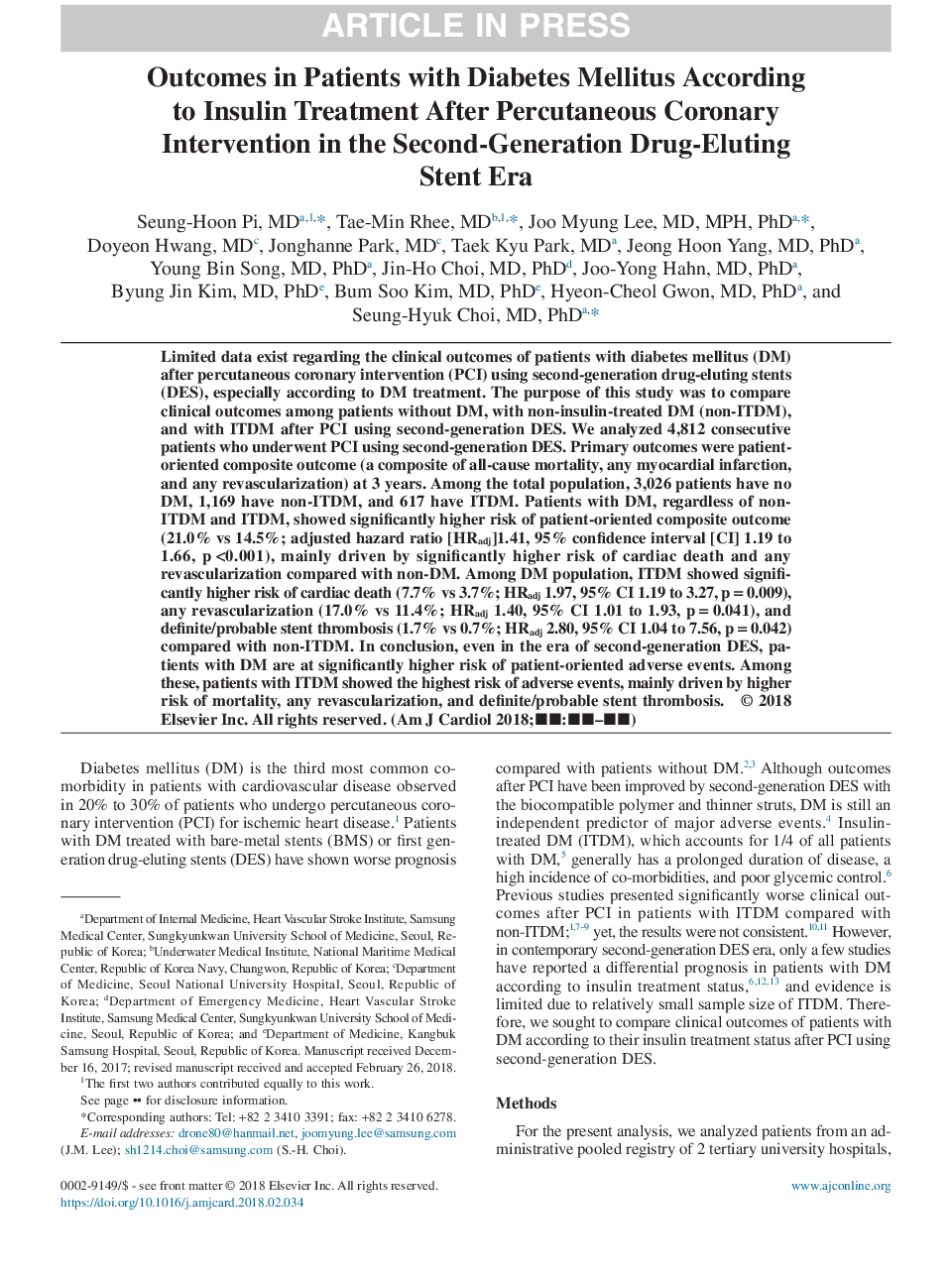| کد مقاله | کد نشریه | سال انتشار | مقاله انگلیسی | نسخه تمام متن |
|---|---|---|---|---|
| 8651218 | 1572058 | 2018 | 7 صفحه PDF | دانلود رایگان |
عنوان انگلیسی مقاله ISI
Outcomes in Patients with Diabetes Mellitus According to Insulin Treatment After Percutaneous Coronary Intervention in the Second-Generation Drug-Eluting Stent Era
ترجمه فارسی عنوان
نتایج در بیماران مبتلا به دیابت با توجه به درمان انسولین پس از مداخله عروق کرونر در دوران استناد داروهای نسل دوم
دانلود مقاله + سفارش ترجمه
دانلود مقاله ISI انگلیسی
رایگان برای ایرانیان
موضوعات مرتبط
علوم پزشکی و سلامت
پزشکی و دندانپزشکی
کاردیولوژی و پزشکی قلب و عروق
چکیده انگلیسی
Limited data exist regarding the clinical outcomes of patients with diabetes mellitus (DM) after percutaneous coronary intervention (PCI) using second-generation drug-eluting stents (DES), especially according to DM treatment. The purpose of this study was to compare clinical outcomes among patients without DM, with non-insulin-treated DM (non-ITDM), and with ITDM after PCI using second-generation DES. We analyzed 4,812 consecutive patients who underwent PCI using second-generation DES. Primary outcomes were patient-oriented composite outcome (a composite of all-cause mortality, any myocardial infarction, and any revascularization) at 3 years. Among the total population, 3,026 patients have no DM, 1,169 have non-ITDM, and 617 have ITDM. Patients with DM, regardless of non-ITDM and ITDM, showed significantly higher risk of patient-oriented composite outcome (21.0% vs 14.5%; adjusted hazard ratio [HRadj]1.41, 95% confidence interval [CI] 1.19 to 1.66, pâ<0.001), mainly driven by significantly higher risk of cardiac death and any revascularization compared with non-DM. Among DM population, ITDM showed significantly higher risk of cardiac death (7.7% vs 3.7%; HRadj 1.97, 95% CI 1.19 to 3.27, pâ=â0.009), any revascularization (17.0% vs 11.4%; HRadj 1.40, 95% CI 1.01 to 1.93, pâ=â0.041), and definite/probable stent thrombosis (1.7% vs 0.7%; HRadj 2.80, 95% CI 1.04 to 7.56, pâ=â0.042) compared with non-ITDM. In conclusion, even in the era of second-generation DES, patients with DM are at significantly higher risk of patient-oriented adverse events. Among these, patients with ITDM showed the highest risk of adverse events, mainly driven by higher risk of mortality, any revascularization, and definite/probable stent thrombosis.
ناشر
Database: Elsevier - ScienceDirect (ساینس دایرکت)
Journal: The American Journal of Cardiology - Volume 121, Issue 12, 15 June 2018, Pages 1505-1511
Journal: The American Journal of Cardiology - Volume 121, Issue 12, 15 June 2018, Pages 1505-1511
نویسندگان
Seung-Hoon MD, Tae-Min MD, Joo Myung MD, MPH, PhD, Doyeon MD, Jonghanne MD, Taek Kyu MD, Jeong Hoon MD, PhD, Young Bin MD, PhD, Jin-Ho MD, PhD, Joo-Yong MD, PhD, Byung Jin MD, PhD, Bum Soo MD, PhD, Hyeon-Cheol MD, PhD, Seung-Hyuk MD, PhD,
